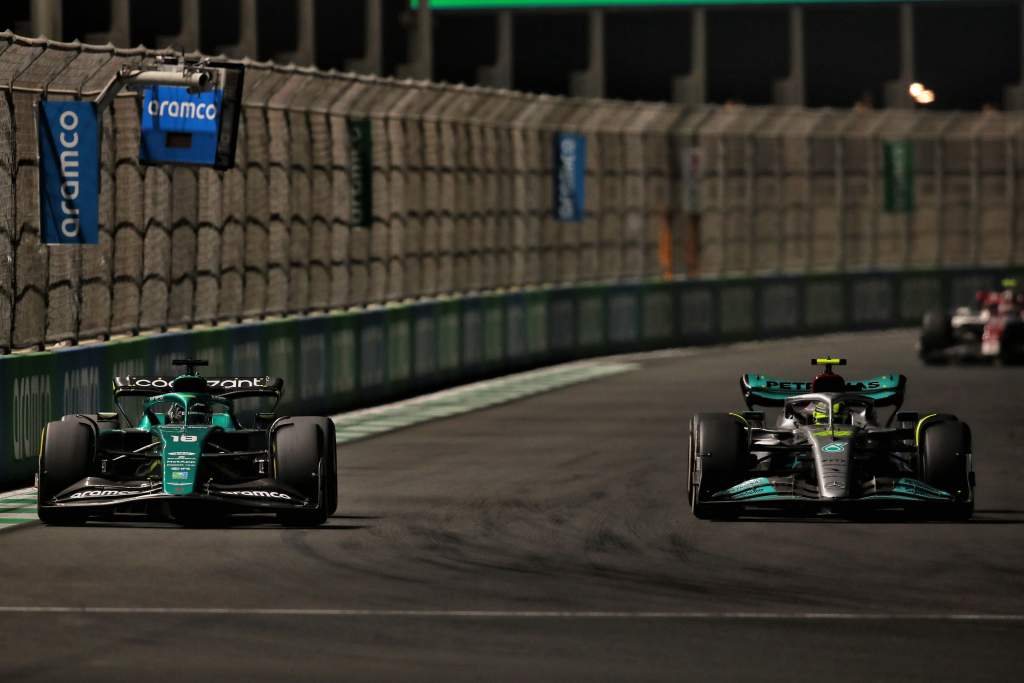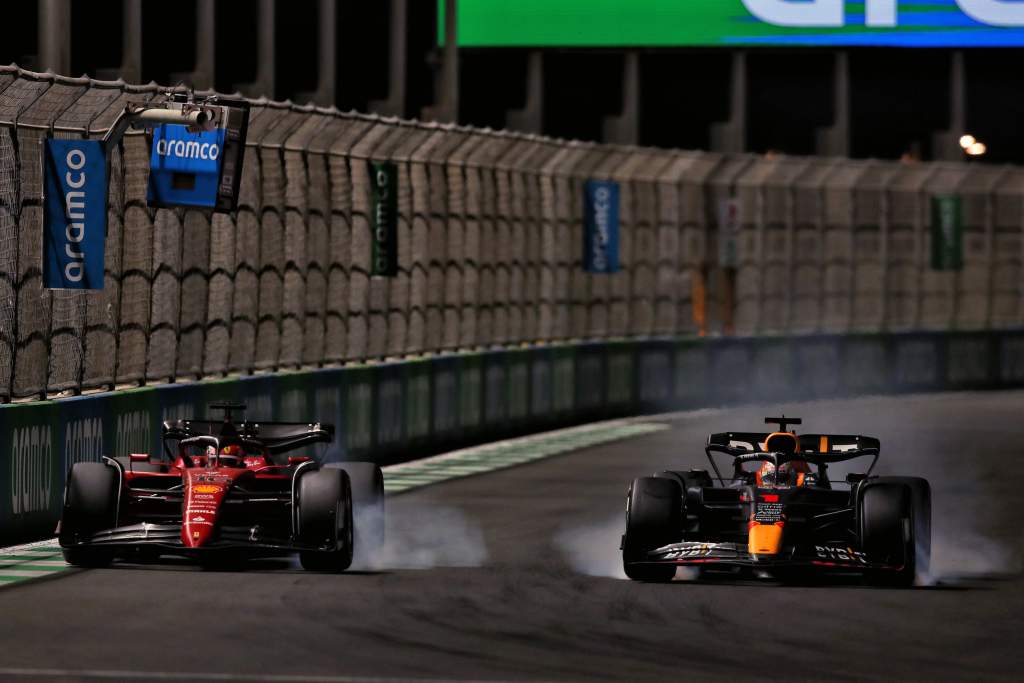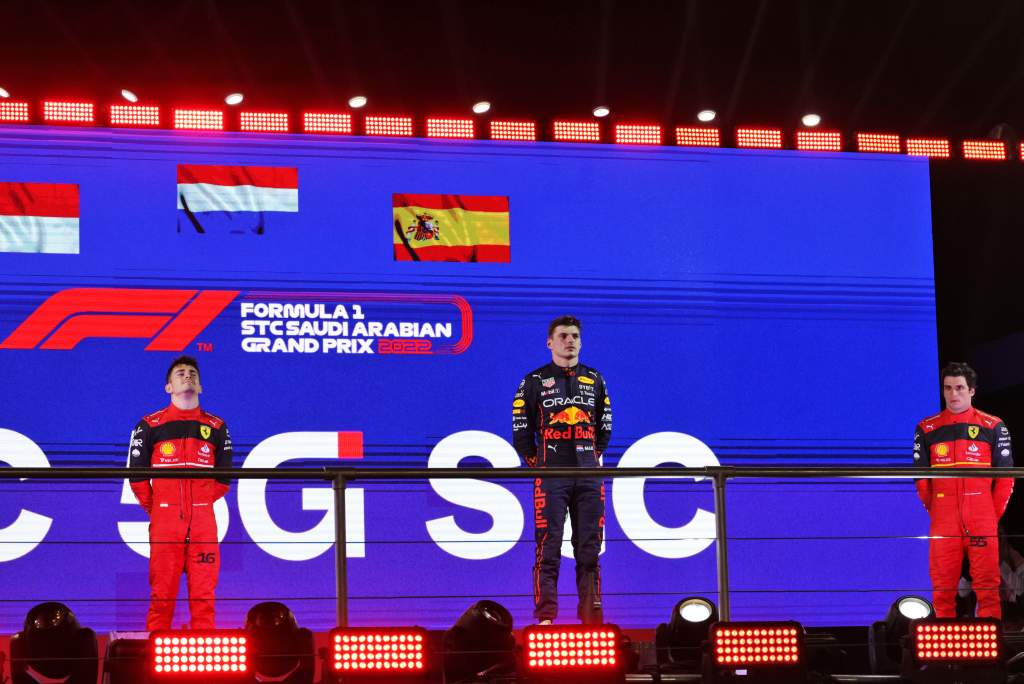Up Next

Max Verstappen and Charles Leclerc continued their game of DRS detection line stand-off from Bahrain but this time it lasted for longer than three laps.
Verstappen was ultimately victorious in the Saudi Arabian Grand Prix, but the outcome was in doubt from the start of the race until very near the end.
The decisive Verstappen pass on Leclerc came four laps from home, though we cannot know how the race might have ended up had polesitter and early leader Sergio Perez not been cruelly disadvantaged by the timing of a safety car just after he had pitted.
But even that timing was forced upon Red Bull by a super-competitive Ferrari.
As the pitstop window opened, Leclerc was pushing hard into the Red Bull’s small cushion. Perez had not been able to pull himself out of the undercut range, not without destroying the medium-compound C3 tyres almost everyone started on.
Now, those tyres were just beginning to surrender. So either Red Bull pitted Perez in anticipation of Leclerc doing the same – or lost the position to the undercut.
Leclerc was always going to do the opposite of Perez. Hence Checo pitted, Leclerc stayed out and a few seconds later Nicholas Latifi crashed his Williams at Turn 27, bringing out the safety car. Which gave everyone the opportunity to zip in for a set of hards to get to the end, with an 11s pit stop loss rather than Perez’s 21s. Which dropped Perez down to fourth (or third, depending upon interpretation).
As Perez voluntarily surrendered third position to Carlos Sainz’s Ferrari upon the resumption of racing and his evening became locked in trying to get back past it, so his awful luck distilled this race down to another Leclerc vs Verstappen duel. An epic one. But with very distinct phases.

Between the lap 21 restart and the lap 36 VSC for the breaking down cars of Fernando Alonso and Daniel Ricciardo, Leclerc withstood everything that Verstappen could throw at him.
It was a beautifully poised contest. The Ferrari, running more wing than the Red Bull, was fast enough in sector one that Verstappen was never able to get within the 1s required at the final turn DRS detection line for the pit straight – or the other two lines at Turns 17 and 22.
The Red Bull was faster at the end of the straights, but just as in Bahrain the Ferrari accelerated harder. Here, it was also quicker in the seven corners which require braking.
The Red Bull was comparably fast over the lap, but the Ferrari was always able to keep it far enough behind at the critical parts of the track. The F1-75 seemed marginally better on the rubber, though that may have just been because Leclerc was running in clear air again.
But certainly the Red Bull had better tyre usage than in Bahrain – and no brake temperature issues this time. So Verstappen pushed on, trying to pressure Leclerc by sheer relentless pace.
But Leclerc was up to it. Even though in the first stint they had been managing the pace a little through the long, fast sweeps of Turns 6-7, 10 and 22, just to give the tyres a breather, now they were on the harder C2 compound they could push hard, edging steadily away from the Sainz/Perez contest.
They in turn pulled a long way clear from George Russell’s Mercedes, which was again around 0.7s off a frontrunning pace. At least George had qualified it in its rightful place, fifth. Lewis Hamilton, trying for a tyre pressure combination that left him with ‘zero rear grip’ failed to make it out of Q1.

From 15th and starting – like Kevin Magnussen and Nico Hulkenberg – on hards, he progressed to be running behind Russell and was doing comparable times on tyres 16 laps older. But in the confusion around the VSC and yellow flags, even that progress was nullified and he’d finish the day a thoroughly dispiriting 10th.
The gap between Leclerc and Verstappen ebbed and flowed according to battery usage and probably mental focus, for it was a long, intense duel, but Leclerc was generally able to keep it at around 1.5s.
Between laps 24 and 35, they traded fastest laps of the race. It seemed that no mater how much Verstappen pushed on, Leclerc ensured the DRS gap remained stubbornly out of his reach. Barring dramas or a late drop-off in tyre performance in the closing laps, Leclerc looked to have it all under control.
Then Alonso’s Alpine – running eighth just behind Magnussen’s Haas and fending off Valtteri Bottas’s Alfa Romeo, having emerged on top of a sometimes brutal-looking duel with team-mate Esteban Ocon – lost drive. A few seconds later so did Ricciardo’s McLaren. They each tried to limp back to the pitlane, but failed to do so. The McLaren stopped actually in the pit entry road. Hence the VSC, with 14 laps left.
This was the perfect opportunity for the three hard-starting runners – Hamilton, Magnussen and Hulkenberg – to stop for their switch to mediums. Hamilton was first upon the scene, having been told to come in but to beware that the instruction might be cancelled if the pitlane was declared closed (the team recalling its error of Monza 2020).
Into this ambiguity Hamilton was thrown by the double waved yellows for the slowing Alonso. He didn’t want to pass it and incur a penalty and so lost over 5s until it was obvious the Alpine was about to stop.
Still uncertain if the pitlane was open or closed and seeing Ricciardo stopped on the entry, he continued. By the time the instruction to pit was repeated, it was too late. Magnussen and Hulkenberg managed to get in before the pitlane was closed.
In the course of Hamilton’s extra lap, the pitlane was then indeed closed, delaying his stop until three laps later. He rejoined near the back, repassed Alex Albon’s Williams and – after a strong resistance – Lance Stroll’s Aston Martin but couldn’t catch Magnussen’s ninth place Haas. A bad day at the office.
But of more significance to the shape of the race was the three-lap VSC’s effect on the tyre temperatures of the leading cars. These were very worn, hard compound tyres. When the tread wears thin and they lose temperature in their core, they can be very reluctant to ever reach optimum temperature again.
In this case, both Verstappen and Perez were able to recover those temperatures quicker than the Ferraris ahead of them. Possibly, their lower downforce settings caused them to slide more, heating up the tread quicker that way. But it meant that Leclerc’s ability to keep Verstappen off his back had dissolved.
Although Leclerc initially got the drop on the Red Bull at the restart, Verstappen getting a snap of oversteer out of Turn 1, two laps of better tyre performance got Max right into the DRS detection points. Now the cat and mouse game around the DRS detection lines began – and the race built to a climax as Verstappen repeatedly attacked and Leclerc played smart, the two leaders swapping position three times in the last few laps.

Verstappen first got DRS on the 42nd lap through the flat-out kink towards the end of the lap, sailing around Leclerc’s outside. But this is followed almost immediately – just before the final turn – by the DRS detection line for the pit straight. Leclerc stayed cool, ensured he was right behind at that line, got the DRS and effortlessly slipped by on the straight.
Next time through there, Verstappen dived for the inside but was determined not to get to the DRS line first – much the same game he played here with Hamilton last year – and actually locked up in his eagerness to stay behind. Leclerc, spotting this, took advantage by standing hard on the gas as Max was still braking. That advantage of reaction meant that even with DRS Verstappen couldn’t get close enough down the pit straight.
It took a couple of laps for Verstappen to get back into DRS range, again using the DRS zone from Turn 24 just to line himself up rather than making the pass. This time he actually turned off his DRS and feathered the throttle just to ensure he was behind at the line. Couple that with a bit of power oversteer from Leclerc on rear tyres which were by now suffering, and Verstappen finally got the move done, taking the lead for good on the pit straight to begin lap 47.
Perez was never able to put the same pressure on Sainz as Verstappen had on Leclerc, though he was clearly faster.
Russell wasn’t really racing anyone in his fifth place, well clear of Ocon who used the Alpine’s considerable straightline speed advantage to keep himself just out of Lando Norris’ reach.
Pierre Gasly was in considerable intestine pain in the closing laps and was very glad to see the chequered flag, in eighth.
Bottas retired from 10th with an overheating Alfa and behind Hamilton, Stroll and Albon collided at Turn 1 fighting for 11th, this bringing out a yellow flag which extinguished any vague chance Leclerc might have had of repassing Verstappen going into the final lap.

Realistically, he didn’t look close enough onto the straight anyway.
Even though disappointed, Leclerc was still thrilled at the intensity of the fight. “This is how racing should always be,” as he put it.
How, if not necessarily where…







